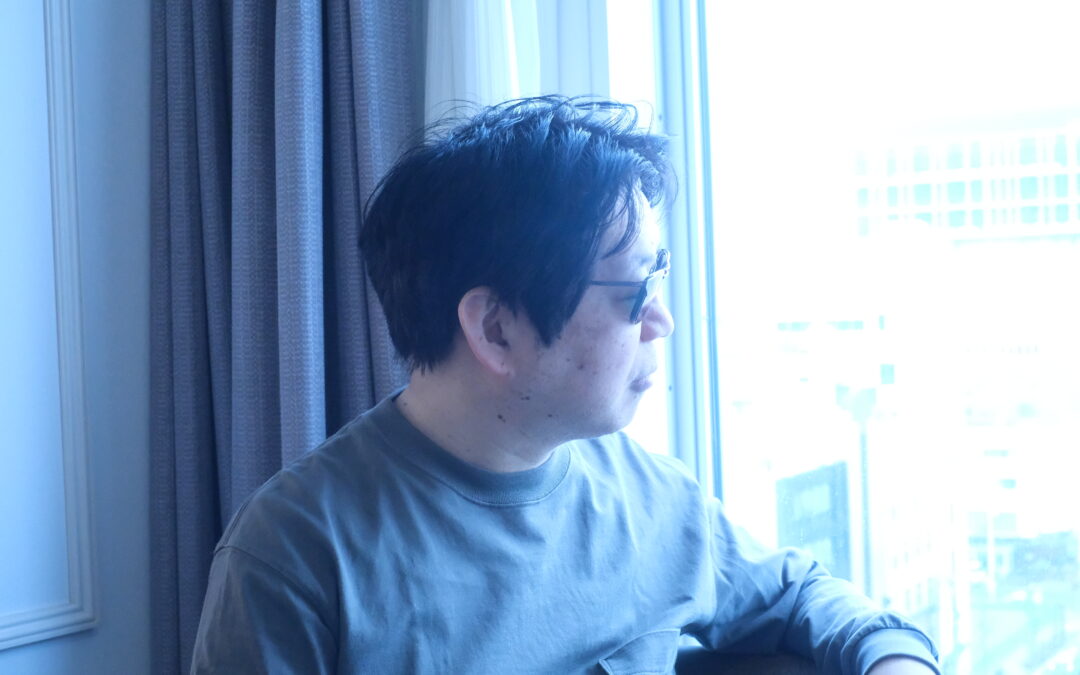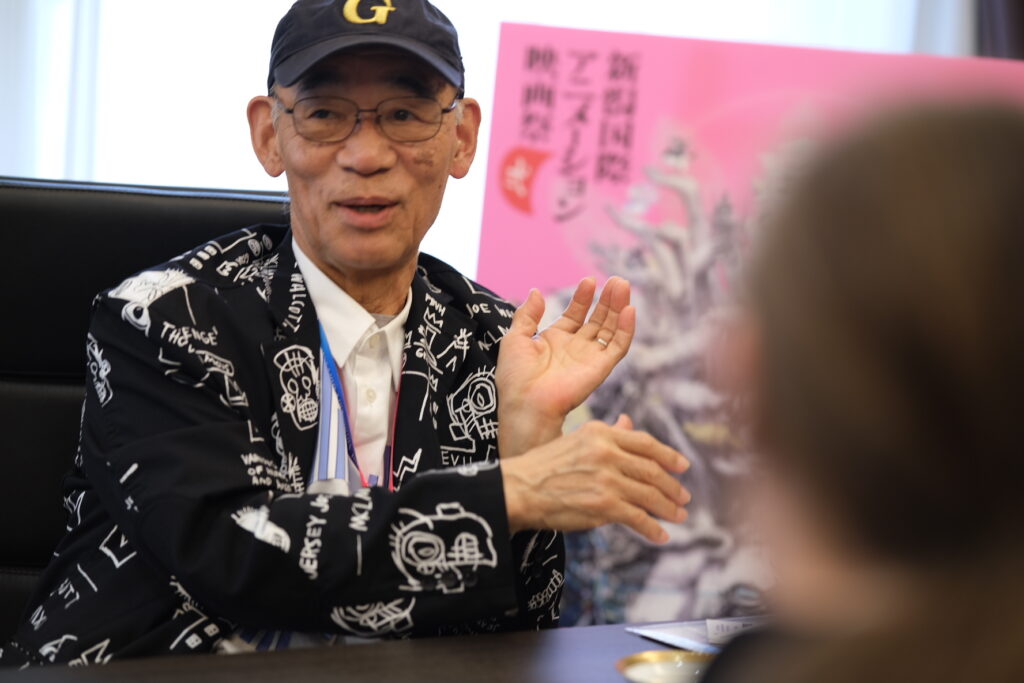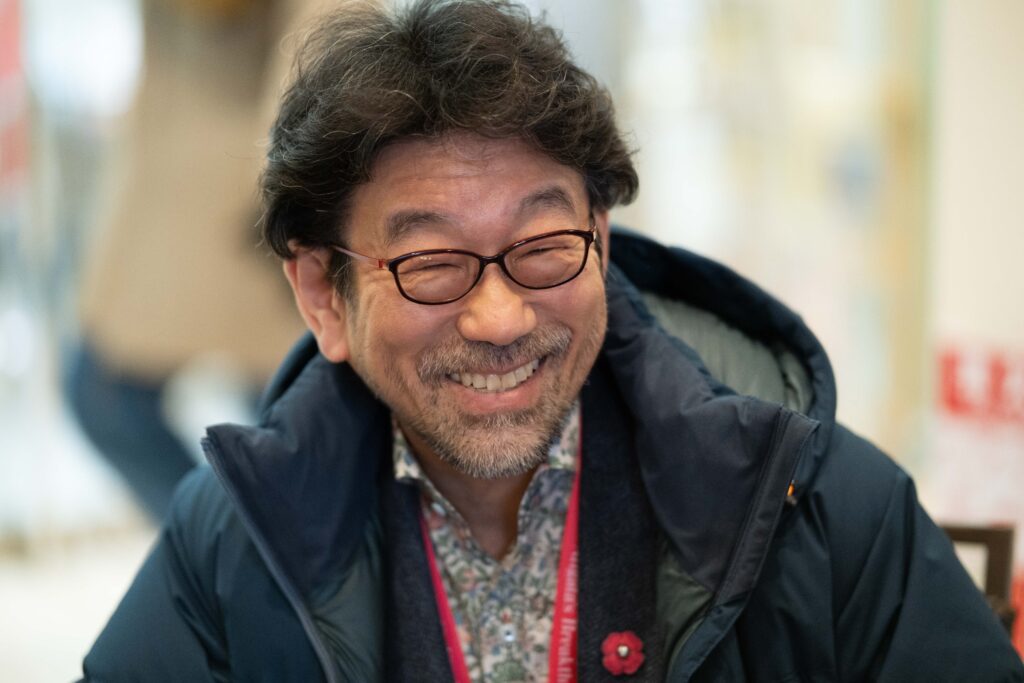While at the Niigata International Film Festival earlier this year, we had the chance to cross paths with the famous anime director Shin’ichirô Watanabe. This is not the first time we met with him, as one of the very first interviews posted on fullfrontal.moe was an interview with Cowboy Bebop‘s director. Between movie screenings, we sat down with Mr. Watanabe to catch up and ask a few questions about his works. He was very surprised, and glad, we did not ask him about Netflix’s Cowboy Bebop live-action series as all foreign media only wanted to discuss this topic with him. Instead, he was very happy to talk about anime and art with us.
Like our content? Feel free to support us on Ko-Fi!
Nowadays, we see a lot of foreigners working on anime, but you’re one of the first directors who scouted foreign artists such as Bahi JD, Thomas Romain, and Stanislas Brunet to work on your series. Can you tell us about what led you to seek out such artists?
Shin’ichirô Watanabe: You see, it might be more related to Space Dandy, but I want to be more free and take more liberties when directing my works. For example, you see… I don’t want to restrain myself by just working with Japanese animators, but I want to take inspiration from all around the world and inject that into my works. Also, when it comes to the “texture” of my characters when animated, I really want to transcribe a “bande-dessinée”-like feeling: I want them to move as if they’re straight out of a comic book. I want to make things that can’t happen in regular TV series.
What bande-dessinée do you like? Things like Moebius, for example?
Shin’ichirô Watanabe: Actually, I like Nicolas de Crécy’s works.
Recently, you were a music producer for Sonny Boy, right?
Shin’ichirô Watanabe: I hadn’t talked with Natsume for some time, but he called me to ask if I didn’t want to help with the music for his new work. But rather than a producer, I’d say I served as an advisor. He’d mention bands and say he wanted things in that style – he’s not very knowledgeable about music, actually. So he wanted help to call for people or to share ideas. I did that, and he made the final choices among the things I suggested. That’s why I was more of an advisor.
Since Hisashi Eguchi did the designs, didn’t you want to go for 80s music?
Shin’ichirô Watanabe: It’s not really that sort of anime to begin with. (laughs) It doesn’t even happen in the 80s.
Yeah, but the vibes. (laughs)
Shin’ichirô Watanabe: I don’t really know how Eguchi Hisashi is viewed in France, but he isn’t really associated with a retro art style in Japan. He’s still drawing today and working on new pieces, so he’s not really an artist “from the 80s”.
I see. Changing topics, I’d like to ask about the J9 series. Would you say you’ve been inspired by it?
Shin’ichirô Watanabe: Wow, I’m surprised you know about it. (laughs) Well, not really. I haven’t really been influenced by them, but I guess you could say the style is somehow similar to Cowboy Bebop.
Yes, it feels like Bebop. Particularly the way it puts the music first…
Shin’ichirô Watanabe: I’ve been told that by other people, too. But you know, talking about Braiger, for example, the opening is awesome, but the series itself isn’t really… (laughs)
I get it. (laughs)
Shin’ichirô Watanabe: So, I don’t think I’ve been too influenced. (laughs)
I see. How about Ryosuke Takahashi? Which do you like best between Votoms and Dougram?
Shin’ichirô Watanabe: I really love Votoms. Wait, is Director Takahashi well-known in France?
Well, his works are well-known, but I’m not sure about him as a person.
Shin’ichirô Watanabe: What about Votoms?
We don’t really watch Votoms over here… maybe more recent stuff like Flag, instead?
Shin’ichirô Watanabe: I’m not sure Flag was that good, though. (laughs)
Is that so? (laughs)
Shin’ichirô Watanabe: Well, it’s got all these info dumps about the mechas… It’s so long, can’t the story start already or something? (laughs)
I kinda liked it. Maybe that’s because I like Legend of the Galactic Heroes…
Shin’ichirô Watanabe: Director Takahashi Ryousuke is my mentor, my master, even… I’ve always unconditionally respected him. I do respect him, but he hasn’t really been working in the industry lately anymore. Instead, he’s been teaching at the Osaka University of Arts. I wish he’d go back to directing.
As for you, why haven’t you directed any live-action yet? Don’t you want to do so?
Shin’ichirô Watanabe: I do, but I didn’t really have any opportunities… Or rather, I had one, but it never happened. We didn’t have money, didn’t find actors, there were multiple reasons… But if I had another opportunity, I’d take it. I’ve always dreamt of doing live-action, and at first, I really hesitated between doing live-action and animation. I ended up doing animation, and my dreams there have kinda come true (laughs), so now I just have live-action left.
Where would you like to do it? In Japan or overseas?
Shin’ichirô Watanabe: I’d like to do something international. If there are any sponsors ready to fund it, please get in touch. (laughs)
Ok. (laughs) Finally, is it okay to ask about Ms. Keiko Nobumoto?
Shin’ichirô Watanabe: She wasn’t just my coworker, she was my best partner, one of a kind. We were really close in private, too, and the news really shocked me when it reached me… My feelings can’t be expressed with words like “it’s sad”, it was too tragic. We got together for my next TV series, and from the very beginning, we exchanged ideas, but then she dropped out, which felt really bad. She felt bad about it as well. She was hospitalized and said things like, “I won’t be able to see this series completed.”, I told her she would, but in the end, she didn’t…
Is there any memory of her you’d like to share?
Shin’ichirô Watanabe: Even when we weren’t working on something, we’d often go to get drinks. She was always cheerful, so I only have fun memories. All the memories of us drinking and having fun. We’d often have debates – you can’t really have these kinds of deep talks in Japan, so it’s really rare to find someone like that, and I always got excited about it. I’m really happy we could have those discussions.
We wish to thank director Shin’ichirô Watanabe and Mr. Aoki for their time and kindness.
Interview by Ludovic Joyet and Matteo Watzky
Transcript and translation by Eileen
Like our content? Feel free to support us on Ko-Fi!
You might also be interested in
Oshi no Ko & (Mis)Communication – Short Interview with Aka Akasaka and Mengo Yokoyari
The Oshi no Ko manga, which recently ended its publication, was created through the association of two successful authors, Aka Akasaka, mangaka of the hit love comedy Kaguya-sama: Love Is War, and Mengo Yokoyari, creator of Scum's Wish. During their visit at the...
Ideon is the Ego’s death – Yoshiyuki Tomino Interview [Niigata International Animation Film Festival 2024]
Yoshiyuki Tomino is, without any doubt, one of the most famous and important directors in anime history. Not just one of the creators of Gundam, he is an incredibly prolific creator whose work impacted both robot anime and science-fiction in general. It was during...
“Film festivals are about meetings and discoveries” – Interview with Tarô Maki, Niigata International Animation Film Festival General Producer
As the representative director of planning company Genco, Tarô Maki has been a major figure in the Japanese animation industry for decades. This is due in no part to his role as a producer on some of anime’s greatest successes, notably in the theaters, with films...





Thanks for the interview, and extra thanks for asking about Nobumoto. She wrote some of my favorite anime/anime episodes. I think she was a great writer, and it’s been disappointing to see so little acknowledgement, let alone discussion, of her work since her passing.
Also, hah, no surprise Watanabe was happy you didn’t ask him about Cowboy Bebop/the live action travesty. I imagine he’s sick and tired of Bebop at this point… (That being said, it doesn’t help that nothing he has done since Champloo lives up to that standard and don’t give a whole lot to talk about… at least in my opinion.)